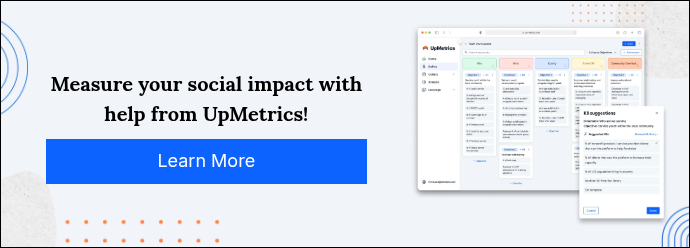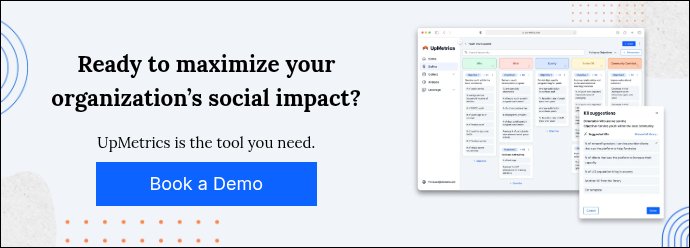Social Impact: Meaning, Importance, and How to Measure It
What is Social Impact?
Defining social impact is complex, encompassing many meanings and perspectives, and there are no rigid rules for its definition.
Broadly speaking, social impact refers to effects—whether positive or negative, intentional or unintentional—of an organization’s actions on the surrounding community.
For nonprofits, social impact measurement is fundamental to allocating resources effectively, demonstrating accountability, and ultimately driving meaningful change. Rather than focusing on simple outputs, measuring social impact empowers nonprofits to assess their profound, and often systemic, impact on society and identify their next steps forward.
Types of Social Impact
Social impact isn’t a question of whether an organization has impacted a community. Instead, it refers to the ways in which organizations impact their communities, including both intended outcomes and unintentional byproducts of initiatives.
We’ve defined the four types of social impact below and provided examples of each:

- Positive: An outcome that contributes to social, environmental, or economic well-being
- Helping ex-felons secure stable employment through a job readiness program, which strengthens both their financial independence and community safety.
- Negative: Undesirable consequences of a well-intentioned program or action
- If the program only places participants in low-wage, unstable jobs, it may perpetuate financial insecurity instead of breaking the cycle.
- Direct: The immediate, observable effects of a program, product, or service
- Offering a job readiness program for ex-felons that helps individuals obtain jobs and re-integrate into society more smoothly
- Indirect: Outcomes (sometimes unintentional) that result from a secondary effect of an action
- Providing a stable home for an ex-felon’s family because they managed to secure a job through your program
Be careful to set accurate parameters for how much indirect impact can be realistically attributed to your organization’s activities. It’s important to be honest and transparent about this to maintain credibility.
Social Impact Themes
Some organizations intentionally frame their social impact efforts around specific categories or areas of focus. These targeted approaches, also known as social impact themes, represent pressing social issues that an organization aims to address through its programs, actions, and investments.
For example, many organizations base their social impact efforts on the 17 UN Sustainable Development Goals, such as:
- Clean water and sanitation
- Zero hunger
- Climate action
- Clean, affordable energy
- Reduced inequality
By focusing on these target areas, nonprofits can center the pursuit of their mission around the community’s needs.
Why Does Social Impact Matter?
Social impact is a fundamental driver for creating meaningful and lasting change in the world. Here’s why:
- It builds trust and transparency between funders and grantees. Funders gain confidence that their investments are creating tangible results, and grantees can clearly articulate their achievements and needs.
- It informs better funding and investment decisions. Social impact measurement provides crucial data for directing resources toward initiatives with the greatest potential for positive change.
- It strengthens learning and collaboration across the ecosystem. Assessing social impact enables organizations to learn from their efforts, adapt their strategies, and collaborate with others for a more effective ecosystem of change-makers.
Every organization, regardless of its sector, plays a vital role in creating and measuring impact. By embracing this responsibility, organizations can contribute to a more equitable and sustainable future for all.
Nonprofits
For public charities, private foundations, and other mission-driven organizations, social change is the entire focus of your work. It defines a mission-driven organization’s very existence and purpose—in other words, it’s the tangible manifestation of your mission. Without a clear and measurable social impact, your organization may struggle to:
- Justify its work: By achieving positive social outcomes, organizations demonstrate they are effectively working towards their stated goals.
- Secure funding: Donors and grantmakers are always looking for evidence of impact. After all, they want to make sure their funds are being used wisely to achieve their donation goals.
- Maintain public trust: Demonstrating social impact builds trust with beneficiaries, donors, and the broader community. It shows that your organization is worthy of donor support.
Ultimately, social impact is a fundamental requirement for nonprofits’ long-term success. It enables mission-driven organizations to maximize their positive impact and continue addressing critical societal needs.
Businesses
It’s a myth that social good is a concept exclusively reserved for charities, nonprofits, and social enterprises. Every organization can benefit from investing in different types of impact.
Corporate social responsibility (CSR) involves businesses holding themselves accountable to the public and investors by remaining mindful of their impact on communities and society as a whole. When a company embraces the CSR model, its commitment to improving society and the environment resonates with employees, consumers, and community members. In fact, CSR statistics show that:
- 55% of employees would accept a lower salary to work for a socially responsible company.
- 77% of consumers want the companies they buy from to have initiatives dedicated to furthering their social impact.
- 73% of investors want to invest in companies that work to improve the environment and society as a whole.
Especially as future generations show an increasing interest in social change—with nearly one-third of Gen Zers engaged in activism or social justice work—CSR efforts present a valuable opportunity for businesses and corporations to achieve positive brand recognition.
How to Measure Social Impact
When it comes to identifying and sharing your organization’s social impact, you’ll need to do more than collect numbers. Social impact measurement is about telling a credible, data-backed story of change.
Instead of simply claiming to drive impact through programs and services, data-driven storytelling empowers your organization to tell the story of its impact—including its next steps. UpMetrics’ DeCAL (Define, Collect, Analyze, and Leverage) methodology provides strategic guidelines for achieving this, outlining the specific steps nonprofits can follow to assess and act on their impact data.
This process involves the following steps:

- Build your impact measurement framework. Your framework defines how you’ll measure, manage, and communicate your impact. At UpMetrics, we’ve created a framework that any organization can leverage to evaluate their dimensions of impact, objectives, and KIIs.
- Focus on important impact metrics first. Identify your desired outcomes, and select key impact indicators (KIIs) that align with your goals. KIIs are a critical component of the framework you’ll use to measure impact, as they’ll inform your data collection and analysis efforts.
- Prioritize data hygiene. Audit your existing database to confirm you’re working with organized, accurate data. Standardize data entry protocols as necessary to keep future data collection consistent with your current records and formatting preferences.
- Measure change over time. Evaluate sustained outcomes, using pre- and post-activity assessments to track your impact. Don’t forget to reconnect with stakeholders after the activity wraps up and note any opportunities to maximize your impact in the future.
- Know the difference between causality and correlation. Causality means your work directly led to the desired outcome, while correlation simply means a relationship exists. For example, did your digital literacy program lead to an increase in the high school’s graduation rate? Or, did the program happen to launch during a period of increased parental involvement and curriculum improvements? Avoid claiming credit for outcomes that may have been influenced by external factors.
Once you’ve followed the steps outlined above, you’re ready to calculate your organization’s social return on investment (SROI). This calculation quantifies the impact your organization makes by connecting dollars spent with the measurable outcomes achieved. Then, you can share your findings with stakeholders and use them to inform future social impact strategies.
3 Organizations Leading the Way in Social Impact
When considering social impact, it’s important to examine how organizations address it in practice. Here are three social impact examples from companies that are improving communities far and wide.
The Los Angeles Dodgers Foundation (LADF)
The Los Angeles Dodgers Foundation (LADF) is dedicated to addressing the most pressing challenges facing communities in Los Angeles. Their efforts span a wide breadth of focuses, including improving education, healthcare, homelessness, and social justice, according to their website.
As a result of these efforts, the Foundation collects large amounts of data, including:
- Registration data
- Participation data
- Survey data
- SEL data
The LADF partnered with UpMetrics to centralize this data, track progress over time, and share compelling stories with stakeholders. Through this partnership, the Foundation was able to identify community needs and respond quickly.
SJF Ventures
SJF Ventures is an impact investment firm that backs high-growth companies creating a cleaner, smarter, and healthier future. The firm's portfolio focuses on multiple themes, including:
- Energy
- Carbon
- Climate resilience
- Education
- Employment
SJF partnered with UpMetrics to streamline impact measurement and improve its reporting efforts. As a result, the firm has been able to move away from simply extracting data and work more collaboratively with companies in its portfolio.
IKEA
In terms of major corporations, IKEA is one of the largest social impact companies.
The Swedish furniture chain has nearly 500 stores worldwide. Since the 1990s, IKEA has committed itself to fighting against child labor practices and providing a future for needy children worldwide.
The company works directly with UNICEF to help achieve this goal. Since 2001, IKEA has donated more than $200 million to the cause.
Furthermore, IKEA has worked to provide clean drinking water to children in underdeveloped parts of the world. Again, they have sponsored countless projects and worked with many global and local charities to accomplish this.
One of their most recent campaigns is the “Let’s Play for Change” initiative. This social impact campaign is designed to help children learn and grow through play.
By creating playing spaces for children in undeveloped areas of the world, IKEA hopes to nurture the development of underserved communities across every continent.
Final Thoughts on Social Impact
At UpMetrics, we believe that data is of no value unless it’s connected to the story of the human experience. Our next-generation Impact Reporting tool makes measuring, optimizing, and showcasing your organization's impact easier than ever before.
Translate your social impact activities into a powerful narrative that inspires employees, investors, and consumers alike.






